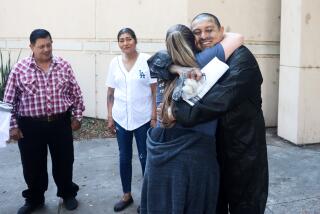Pain Abounds When Murder Is All in the Family
DALLAS — Jerry Evers no longer stands at the graves of his three little girls, begging God to bring them back.
After 21 years, he has accepted the fact that the children are gone. What remains is the pain.
“I’m in my own prison,” Evers said. “I have to live with this every day.”
Two decades before Andrea Yates told Houston police that she drowned her five children, Evers’ wife systematically held their three girls under water in a bathtub in Leesburg, Fla. Dianne May Evers was found innocent by reason of insanity. She has been confined to a state hospital ever since.
Each year, hundreds of children in the United States are cut off from what should have been a worry-free path to adulthood at the hands of a parent. Although statistics at three national databases vary, the National Center on Child Fatality Review puts the number as high as 2,000 children a year.
Experts say filicide, the murder of a child by a parent, dates to ancient times, but seems more prevalent today because of media attention given to dramatic cases. They range from the sensationalism of the Yates case to a teenage mother’s dumping of her unwanted newborn to shaken baby syndrome.
“Back in Queen Victoria’s day, people would have closed their mind to such things,” said Randell Alexander, a child abuse expert at Morehouse School of Medicine in Atlanta. “It’s still hard to believe it would happen to people we would know, or people who look like us.”
Professionals can tally numerous reasons for the slayings. Preventing them is more elusive.
“I can’t think of a real easy solution to it,” Alexander said. “If they were all being shot, we could go for the guns. But they’re not just being shot. They’re being stabbed. They’re being drowned.”
The violent death of a child strikes a strong emotional chord in the public consciousness. For some investigators accustomed to the most heartbreaking of crimes, it is almost too much to bear.
“If you have children, those are the faces you see with the dead children. It would take a real insensitive person not to feel something,” said Gene Blair, director of the Institute for Law Enforcement Training at Sam Houston State University in Huntsville.
In 1994, Susan Smith of Union, S.C., tearfully told investigators that a black man stole her car and drove off with her two little boys. Nine days later, she shocked the nation by admitting she rolled the car into a lake with the children strapped into their car seats.
Defense lawyers said Smith was mentally ill and portrayed the drownings as a failed attempt at suicide. She was convicted nonetheless and sentenced to life in prison. The case inspired books, television documentaries and even an off-Broadway play.
Others cases followed, one just as incomprehensible as the next.
In Darlie Routier’s case, police believe she was trying to escape financial problems and the burdens of motherhood when she stabbed her 5- and 6-year-old boys in 1996. She was convicted and is on Texas’ death row.
John Battaglia, a Dallas accountant, said he felt overwhelmed by his workload and battles with his ex-wife. Police said he shot and killed his two young daughters in May during a telephone conversation with his ex-wife. He stands accused of capital murder.
Prosecutors plan to seek the death penalty against Yates, who was charged with the bathtub drownings in June of her five children, ranging in age from 6 months to 7 years.
Russell Yates has publicly stated that he is standing behind his wife. He describes her as a devoted mother suffering from severe postpartum depression.
Jerry Evers, too, was supportive of his wife immediately after the 1980 drownings.
Although Dianne Evers had suffered hallucinations, Evers never anticipated she would hurt their 4-year-old twin girls and 2-year-old daughter. Months later, Dianne Evers told psychiatrists she was the Virgin Mary and God told her the children would be better off in heaven.
Over time, as the weight of the loss grew heavier, Jerry Evers’ support faded.
“I wish I could understand it,” he said. “I don’t know how anybody in the world can harm a child.”
Evers has since remarried and lives in rural Georgia. A soft-spoken 44-year-old, he hesitates to let his three children out of his sight and has had difficulty holding jobs in his chosen field of law enforcement.
DePaul University law professor Michelle Oberman said her decade of studying mothers who kill their children unveiled a common thread involving parenting issues.
Often, the women are primary caretakers who feel isolated and overwhelmed. Many of the deaths would have been preventable, Oberman contends, had someone noticed the warning signs.
“For many mothers, isolation is bliss,” said Oberman, co-author of “Mothers Who Kill Their Children.” “For some women, it’s a prescription for some level of disaster.”
Pathologists at the University of Texas Southwestern Medical Center at Dallas have tied parental killing of children to 16 different situations. They’re discussed in a 1999 article in the American Journal of Forensic Medicine and Pathology.
“Filicide occurring during the postpartum period can involve command hallucinations or delusions that the newborn is destined for a terrible fate, is possessed by the devil, or has special powers,” the authors said.
Spousal revenge, violent outburst or angry impulse, and euthanasia are also among the reasons listed for filicide.
“The most common one we see is the angry outburst, where an angry parent strikes the child or throws the child down. The parent is not trying to deliberately kill the child,” said Dr. Joseph Guileyardo, lead author and a former deputy chief medical examiner for Dallas County.
An altruistic killing involves a parent, sometimes delusional, who believes the child must be spared from some terrible fate.
Guileyardo’s article suggests ways to prevent such chilling acts: provide community access to immediate psychiatric care, intervene at the first sign of child abuse, make social workers aware of the need to take “unwanted” children.
But some child advocates say discussing prevention is useless until the judicial system gets tougher on parents who commit such crimes.
They point to judges who grant visitation rights to parents with a history of family violence. Society, they believe, is beset with misplaced priorities, more troubled by the prospect of strangers harming children than family members.
“What we see is you don’t get the same punishment when you kill your own child as when a stranger kills a child,” said Nancy Ruhe-Munch, executive director of the Cincinnati-based Parents of Murdered Children Inc. “Like Susan Smith. She drowned her own children, but she didn’t get the death penalty.”
More to Read
Sign up for Essential California
The most important California stories and recommendations in your inbox every morning.
You may occasionally receive promotional content from the Los Angeles Times.










